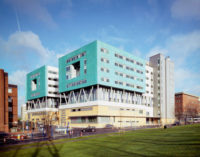Houston
Completion Date: October 2010
Total construction cost: $178 million
Gross square footage: 430,000 square feet
People
Owner
Design Architect:
Architect of Record:
Associate Architect:
Personnel in architect's firm who should receive special credit:
Architect of record: WHR Architects (Executive Architect) Associate architect(s): CO Architects (Design Architect for the Methodist Institute for Technology, Innovation and Education {MITIE} on Level 5’s Surgery Training facility)
Interior designer(s)
Engineers: Structural Engineer: Haynes Whaley Associates, Inc. Civil Engineer: Walter P. Moore & Associates, Inc.
Consultant(s)
Other: Construction Manager / General contractor: D. E. Harvey Builders
Photographer(s)
CAD system, project management, or other software used: |
Products
Exterior cladding: American Stone
Roofing
Glazing
Doors Wood doors: IPIK Door Co.
Hardware Hinges: McKinney Closers: Norton Exit devices: Von Duprin Security devices: Schneider Electric
Interior finishes
Furnishings Electrical Contractor: Fisk Electric
Conveyance HVAC & Plumbing Contractor: Gowan, Inc. |









Post a comment to this article
Report Abusive Comment